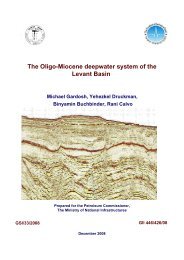The Geology of the Elat Sheet Explanatory Notes
The Geology of the Elat Sheet Explanatory Notes
The Geology of the Elat Sheet Explanatory Notes
Create successful ePaper yourself
Turn your PDF publications into a flip-book with our unique Google optimized e-Paper software.
in very different environment than those <strong>of</strong> <strong>the</strong> Judea Group. Sedimentation <strong>of</strong> <strong>the</strong> Mt.<br />
Scopus Group occured in an unstable shelf rich in nutrients and organic material while<br />
<strong>the</strong> Judea Group was deposited in a shallow sea poor in nutrients and tectonically stable.<br />
<strong>The</strong> Gareb Formation <strong>of</strong> Maastrichian age is built <strong>of</strong> well-bedded yellow-reddish marly<br />
chalk with gypsum veins and is up to 70 m thick. It is exposed in <strong>the</strong> Taba, Rehavam,<br />
Shelomo and Shehoret west synclines and a in small outcrop at Nahal Netafim at <strong>the</strong><br />
nor<strong>the</strong>rn terminus <strong>of</strong> <strong>the</strong> Yotam Graben. <strong>The</strong> Taqiye Formation is built <strong>of</strong> green clay<br />
and marl with limonitic nodules with pyrite at <strong>the</strong> center. <strong>The</strong> Taqiye Formation was<br />
mostly mapped in association with <strong>the</strong> Gareb Formation. <strong>The</strong> thickness <strong>of</strong> both<br />
formations ranges from a few meters to a few tens <strong>of</strong> meters. <strong>The</strong> boundary between <strong>the</strong><br />
Gareb and Taqiye formations is <strong>the</strong> base <strong>of</strong> <strong>the</strong> Cenozoic Era and Tertiary System which<br />
is characterized by a biological turnover such as <strong>the</strong> extinction <strong>of</strong> <strong>the</strong> dinosaurs.<br />
Correlation, isopach and facies maps for <strong>the</strong> formations <strong>of</strong> <strong>the</strong> Judea and Mount Scopus<br />
groups for <strong>the</strong> nor<strong>the</strong>rn Negev and Sinai are presented by Bartov and Steinitz (1977).<br />
3.2.5 Avedat Group <strong>of</strong> Eocene age is built <strong>of</strong> four formations: Mor, Nizana, Horsha and<br />
Matred. <strong>The</strong> Eocene rocks are exposed in <strong>the</strong> Nahal Shelomo, Rehavam and Taba<br />
synclines are built <strong>of</strong> well bedded white chalk with chert interbeds and limestone<br />
concretions up to 1 m in diameter. <strong>The</strong> Eocene rocks are up to 100 m thick at Nahal Taba<br />
(Eyal, 1967) and <strong>the</strong>y are most probably <strong>the</strong> equivalent <strong>of</strong> <strong>the</strong> Mor Formation <strong>of</strong> Early to<br />
Middle Eocene. At Nahal Shelomo syncline <strong>the</strong> top <strong>of</strong> this formation is truncated by <strong>the</strong><br />
Raham Conglomerate.<br />
3.3 <strong>The</strong> young clastic rocks (previously called <strong>the</strong> Upper Clastic Unit) <strong>of</strong> Miocene-<br />
Pliocene-Pleistocene age were deposited as a result <strong>of</strong> <strong>the</strong> rifting. At <strong>the</strong> northwest rift<br />
margins at <strong>the</strong> Shaham planes and Nahal Shani <strong>the</strong> Arava Formation (Avni et al., 2001)<br />
and <strong>the</strong> Zehiha Formation (Ginat, 1997, 2001) were mapped overlying <strong>the</strong> Oligocene<br />
peneplain. <strong>The</strong> Arava Formation is a fluvio-lacustrine formation build <strong>of</strong> conglomerates<br />
<strong>of</strong> Pliocene age, deposited between 4-2 Ma at a relative tectonically stable phase along<br />
<strong>the</strong> margins <strong>of</strong> <strong>the</strong> rift after intensive rifting phase that controlled <strong>the</strong> Miocene-Pliocene<br />
drainage pattern (Avni et al., 2001). <strong>The</strong> Sagi Member <strong>of</strong> <strong>the</strong> Arava Formation up to 30<br />
meters was mapped in <strong>the</strong> <strong>Elat</strong> <strong>Sheet</strong> as a conglomerate consisting <strong>of</strong> boulders <strong>of</strong> local<br />
origin mainly <strong>of</strong> carbonates and less <strong>of</strong> chert and rhyolite, rounded and up to 3 meters in<br />
diameter. <strong>The</strong> average imbrication <strong>of</strong> <strong>the</strong> boulders indicate westward flow direction. <strong>The</strong><br />
Arava Formation unconformably overlays <strong>the</strong> Mt. Neshef rhyolites and <strong>the</strong> Judea and<br />
Mount Scopus groups. <strong>The</strong> Zhiha Formation <strong>of</strong> Pleistocene age is built <strong>of</strong> fine-grained<br />
sandstone to red clayey-silt and unconformably overlies <strong>the</strong> Arava Formation. Beds <strong>of</strong><br />
calcitic paleosoils with carbonate concretions formed by pedogenic processes are<br />
common in <strong>the</strong> Zhiha Formation different from <strong>the</strong> more recent gypsiferous soils. <strong>The</strong>se<br />
soils <strong>of</strong> <strong>the</strong> Zhiha Formation were developed in close basins along <strong>the</strong> Pleistocene major<br />
rift fault systems when <strong>the</strong> flow direction in <strong>the</strong> rivers changed from west toward <strong>the</strong> east.<br />
<strong>The</strong> calcitic paleosole probably indicate a more humid, semi-arid, climate than <strong>the</strong><br />
present extreme-arid climate. <strong>The</strong> thickness <strong>of</strong> <strong>the</strong> Zhiha Formation is around 10 meters.<br />
In <strong>the</strong> rift zone west <strong>of</strong> <strong>Elat</strong> at Nahal Shelomo <strong>the</strong> Miocene Raham Conglomerate was<br />
mapped (Garfunkel et al., 1974) and north and south <strong>of</strong> <strong>Elat</strong> <strong>the</strong> Elot and Gar<strong>of</strong><br />
formations (Ginat et al., 1994). <strong>The</strong> Raham Conglomerate is a poorly sorted, coarse<br />
conglomerate in which <strong>the</strong> boulders are rounded-angular and are composed mainly <strong>of</strong> <strong>the</strong><br />
Avdat Group with nummulites without magmatic and metamorphic boulders. Avni et al.,<br />
(2011) suggested <strong>the</strong> Raham Conglomerate to be <strong>of</strong> <strong>the</strong> Eocene age. <strong>The</strong> Elot Formation<br />
<strong>of</strong> Pliocene age is up to 20 meters thick and is built <strong>of</strong> two units: <strong>The</strong> lower brown-light<br />
7

















